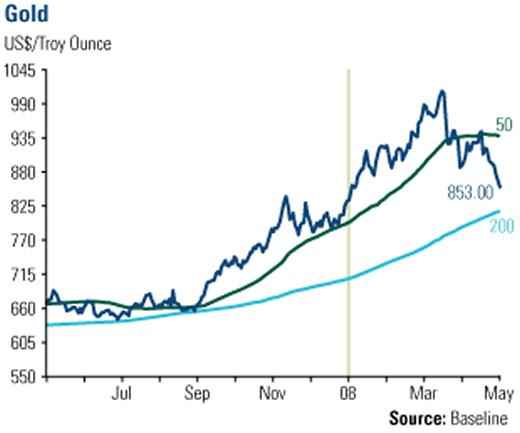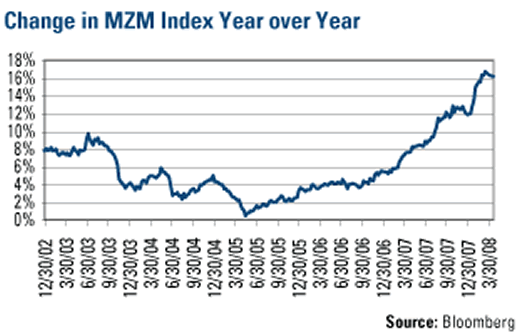Factors In Defense of Gold
Commodities / Gold & Silver May 05, 2008 - 12:58 PM GMTBy: Frank_Holmes
The price of gold has corrected by close to 20 percent since peaking on March 17. If you have been listening to the popular press and business TV, you may be convinced that the gold and commodity “bubbles” have popped.
Once you back away from the day-to-day noise and put things into perspective, we believe this correction in gold, while painful in the short term, is just another pause in a long-term secular bull market. As it has been said, bull markets climb a wall of worry.

Over the past year, gold bottomed around $640 per ounce in late June. As the financial crisis unfolded, it staged a spectacular rally, surging more than 60 percent to $1,032. Gold has since pulled back, but given that the long-term fundamentals remain intact, we believe it is setting the stage for the next leg up.
Here are some of the reasons why:
Negative real interest rates
The macro environment for gold is still supportive based on negative real interest rates. The one-year Treasury bill is offering just 2 percent, while the official inflation rate is around 4 percent.
Negative interest rates make gold look more attractive compared with other safe investment alternatives, such as T-bills and certificates of deposit.
We believe the Federal Reserve will keep interest rates below the rate of nominal economic growth in order to support a fragile economy in an election year.
Negative real rates between mid-2001 and spring 2005 powered gold's biggest bull run in decades, with prices rising from $255 to $455 per ounce.
Real inflation is underreported
The official inflation rate is around 4 percent, but when you include the rapidly rising prices for food and energy and understated housing costs, the real inflation rate is even higher.
One of the best ways to protect yourself against inflation is to participate in it by investing in commodities such as oil and agricultural products. Historically, gold also has proven to be a viable hedge against rising inflation because it maintains its purchasing power.
We agree with those who estimate that the actual inflation rate is close to double digits due to the Fed's massive injection of new money into the economy to avert a recession. MZM (money zero maturity), the amount of money in the economy that's easily accessible for spending, is up 15 percent compared with the same time last year.

ETF redemptions
The current correction in gold has been led by sizable ETF redemptions.
The StreetTracks Gold Shares ETF (ticker GLD) lost 1.3 million ounces of gold over the past two weeks, with nearly a third of that amount being redeemed this Tuesday alone. This may mark the first-ever ETF-led gold correction.
This correction is not surprising, given the strong acceleration in the first quarter of 2008 and typical seasonal trends. Some short-term profit-taking is likely, along with speculation that prospects have improved in financials and technology.
But in our opinion, this move out of gold is not indicative of the smart money, as momentum investors chased performance on the way up. The price action appears to be signaling a rotation from weak gold holders, perhaps back into the broader equity market.
Other factors
On top of the factors above, there are other fundamental factors that we believe will drive the price of gold higher over the longer term.
Declining output from existing mines, particularly in South Africa , and a virtual absence of large new discoveries will reduce the supply of gold available in the market.
At the same time that gold supply is falling, demand is increasing due to rising wealth levels in China , India and other nations with cultural affinity for gold.
In addition, history suggests that jewelry demand, which fell off when gold surpassed the $1,000 mark, is likely to pick up again during a gold-price retrenchment.
It's easy for investors to get swept up in the emotion of a strong rally or a significant correction. In these volatile times, we suggest that investors protect themselves from suboptimal decision-making by not losing sight of their long-term asset allocation strategy.
By Frank Holmes, CEO , U.S. Global Investors
More timely commentary from Frank Holmes is available in his investment blog, “Frank Talk”: www.usfunds.com/franktalk .
Material for this article contributed by John Derrick, director of research, U.S. Global Investors.
All opinions expressed and data provided are subject to change without notice. Some of these opinions may not be appropriate to every investor. Gold funds may be susceptible to adverse economic, political or regulatory developments due to concentrating in a single theme. The price of gold is subject to substantial price fluctuations over short periods of time and may be affected by unpredicted international monetary and political policies. We suggest investing no more than 5% to 10% of your portfolio in gold or gold stocks. The following securities mentioned in the article were held by one or more of U.S. Global Investors family of funds as of 12-31-07 : streetTRACKS Gold Trust.
Frank Holmes Archive |
© 2005-2022 http://www.MarketOracle.co.uk - The Market Oracle is a FREE Daily Financial Markets Analysis & Forecasting online publication.



